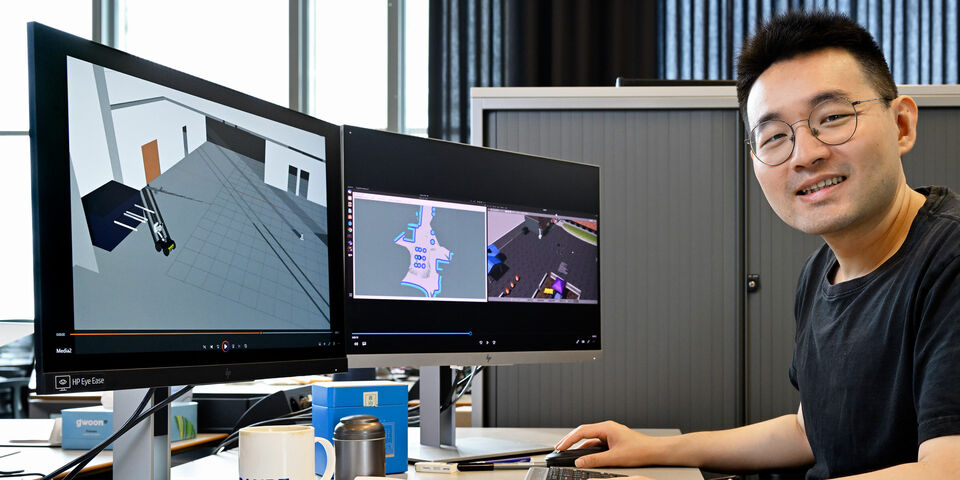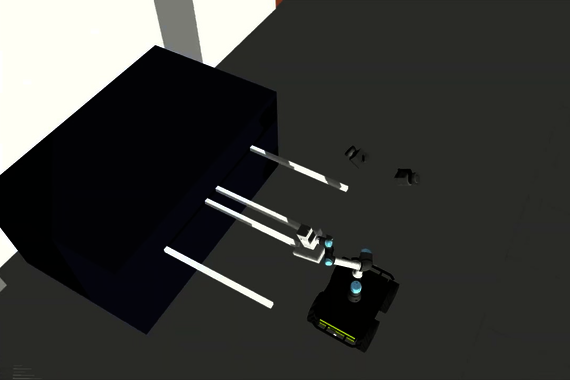Home Stretch | Building with robots
Robots have the potential to take over heavy, repetitive, and dangerous construction tasks from humans. However, due to high costs and other practical obstacles, robots are still rarely used on construction sites. To address these challenges, PhD candidate Aiyu Zhu developed a simulation platform tailored to the needs of the AEC industry. This simulation environment creates the opportunity to further investigate and optimize robotization on construction sites. Today, Zhu will be defending his dissertation at the Department of Built Environment.
"In the future, we can use robots to perform heavy construction work," says the Chinese-born PhD candidate who earned his master's degree in civil engineering from California State University in the United States. The construction industry could benefit enormously from construction robots that work faster, safer, cheaper, and more sustainably than humans, but this potential is currently underutilized. "Robots are already widely used in prefabrication, but on the construction site you hardly see them," Zhu says.
Dynamic environment
"There are several factors hindering robotization in construction," he continues. As one of the oldest industries in the world, the construction industry is quite traditional and rigid. "While other branches of industry are developing at lightning speed and deploying the latest technologies, construction still relies mostly on manual work, and manufacturing processes and management haven’t been digitized and automated to any real degree," he states. This is an obstacle to the adoption of innovations.
"What also comes into play is the budget, because robots are very expensive," he goes on. Purchasing robots requires a large investment that does not pay itself back in the short term. "Another reason why construction robots are rarely seen on building sites is that these environments are very complicated, unlike fixed-in-place manufacturing plants," Zhu explains. "You can't build an assembly line for construction work because the construction process is very dynamic." Integrating robots into such a dynamic environment, assigning them tasks, and managing the whole process is a big challenge. "Humans have language and can process all kinds of information, but robots do not, so it takes good digital planning and management to guide robotic construction."
Simulation platform
Many of the obstacles can be overcome by a simulation environment specifically designed for the needs of the construction industry, is how Zhu reasoned four years ago when he started his PhD research at TU/e. "If a company or university wants to research robotic construction, it usually buys construction robots and starts using them, which is very expensive. But if we have a good simulation platform, then you don’t need real robots and you can just use a computer to study robotic construction and see what works and what doesn't work. That way you can further optimize robotization and solve specific challenges without investing a lot of money, at the same time ensuring that the integration of real robots on the construction site is more likely to be successful right away.”
Zhu developed such a simulation environment, making use of BIM (Building Information Modeling). BIM is a digital model of an existing or planned structure, composed of objects to which information is linked. So it is not just a 3D model of the structure, but a comprehensive data model that contains detailed information about building components, such as material, thickness, and price. This makes it a useful tool that enables architects and engineers to manage construction projects efficiently. In addition, according to Zhu, it is an important component of digital transformation in construction, because BIM can be integrated with other systems. As such, BIM also played a crucial role in developing the simulation platform.
"We can extract all the information about the structure and the components from BIM and put it into the simulation environment, together with the robots. By doing so, we can mimic the construction environment exactly. So we can first let the robots build in the simulation environment and see the results, without buying real robots," he explains. Zhu flips open his laptop and shows a simulation video in which a robot picks up a component and puts it in the right place (see the video below). "So as you can see, you get a real visual representation of what happens when you give the robot a task."
Designing better robots
By simulating the behavior of robots in specific environments, you can design better robots more efficiently and cheaply, Zhu argues. Robotic simulation is already widely used, he points out, but usually it only looks at the robot’s performance instead of how it interacts with the environment. The simulation environment developed by Zhu combines two crucial things: the robots and the construction environment.
With simulation experiments, the interaction dynamics between the robots and the environment can be investigated before any real robots are made. "You can look at the performance of the robots in different scenarios and, based on that, further redesign the robots and test them again in the simulation environment until everything works well there. The next step is to start making real robots, which perform better than if you hadn't done these simulation experiments," he explains.
Open source
The simulation environment is not only generic and flexible enough to suit all types of components and robots, but the software is also open source, so anyone can use it. "There are already simulation environments for robotic construction, such as RhinoRobot, but you need a license for those. In addition, such programs limit themselves to existing robots, so you can't redesign them and test the modified robots in the simulation environment." A great deal of theoretical research has recently been done on this topic, but the simulation platform is a readily applicable tool that could accelerate robotization in construction.
So will construction workers soon have robots as 'colleagues'? Zhu doesn't think so, because he believes robots will completely replace humans on construction sites in the future. "The construction environment is dangerous and there's a lot of air pollution, so I think it would be for the best if you don't need to involve any humans." Continuing to ponder the future, Zhu says: "If mankind is going to build things on the Moon or Mars in the future, you could definitely use robots for that as well, so you don't have to send people there." But let’s head back to Earth for a moment. In Zhu’s most optimistic scenario, robots could replace humans as early as 20 or 30 years from now. But first, more research needs to be done and experiments need to be conducted, in which respect his platform can be of tremendous help.



Discussion